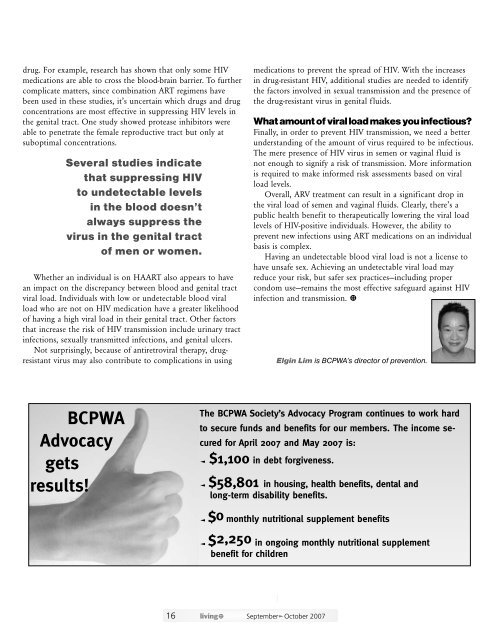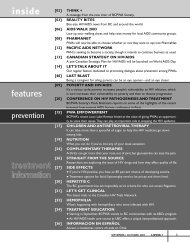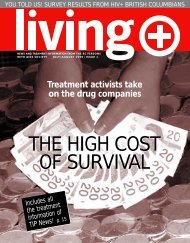iv poz mag.qxd - Positive Living BC
iv poz mag.qxd - Positive Living BC
iv poz mag.qxd - Positive Living BC
Create successful ePaper yourself
Turn your PDF publications into a flip-book with our unique Google optimized e-Paper software.
issue 50.<strong>qxd</strong>:l<strong>iv</strong> <strong>poz</strong> <strong>mag</strong>.<strong>qxd</strong> 9/3/07 4:04 PM Page 16<br />
drug. For example, research has shown that only some HIV<br />
medications are able to cross the blood-brain barrier. To further<br />
complicate matters, since combination ART regimens have<br />
been used in these studies, it’s uncertain which drugs and drug<br />
concentrations are most effect<strong>iv</strong>e in suppressing HIV levels in<br />
the genital tract. One study showed protease inhibitors were<br />
able to penetrate the female reproduct<strong>iv</strong>e tract but only at<br />
suboptimal concentrations.<br />
Several studies indicate<br />
that suppressing HIV<br />
to undetectable levels<br />
in the blood doesn’t<br />
always suppress the<br />
virus in the genital tract<br />
of men or women.<br />
Whether an ind<strong>iv</strong>idual is on HAART also appears to have<br />
an impact on the discrepancy between blood and genital tract<br />
viral load. Ind<strong>iv</strong>iduals with low or undetectable blood viral<br />
load who are not on HIV medication have a greater likelihood<br />
of having a high viral load in their genital tract. Other factors<br />
that increase the risk of HIV transmission include urinary tract<br />
infections, sexually transmitted infections, and genital ulcers.<br />
Not surprisingly, because of antiretroviral therapy, drugresistant<br />
virus may also contribute to complications in using<br />
medications to prevent the spread of HIV. With the increases<br />
in drug-resistant HIV, additional studies are needed to identify<br />
the factors involved in sexual transmission and the presence of<br />
the drug-resistant virus in genital fluids.<br />
What amount of viral load makes you infectious?<br />
Finally, in order to prevent HIV transmission, we need a better<br />
understanding of the amount of virus required to be infectious.<br />
The mere presence of HIV virus in semen or vaginal fluid is<br />
not enough to signify a risk of transmission. More information<br />
is required to make informed risk assessments based on viral<br />
load levels.<br />
Overall, ARV treatment can result in a significant drop in<br />
the viral load of semen and vaginal fluids. Clearly, there’s a<br />
public health benefit to therapeutically lowering the viral load<br />
levels of HIV-posit<strong>iv</strong>e ind<strong>iv</strong>iduals. However, the ability to<br />
prevent new infections using ART medications on an ind<strong>iv</strong>idual<br />
basis is complex.<br />
Having an undetectable blood viral load is not a license to<br />
have unsafe sex. Achieving an undetectable viral load may<br />
reduce your risk, but safer sex practices—including proper<br />
condom use—remains the most effect<strong>iv</strong>e safeguard against HIV<br />
infection and transmission. 5<br />
Elgin Lim is <strong>BC</strong>PWA’s director of prevention.<br />
<strong>BC</strong>PWA<br />
Advocacy<br />
gets<br />
results!<br />
The <strong>BC</strong>PWA Society’s Advocacy Program continues to work hard<br />
to secure funds and benefits for our members. The income secured<br />
for April 2007 and May 2007 is:<br />
t $1,100 in debt forg<strong>iv</strong>eness.<br />
t $58,801 in housing, health benefits, dental and<br />
long-term disability benefits.<br />
t $0 monthly nutritional supplement benefits<br />
t $2,250 in ongoing monthly nutritional supplement<br />
benefit for children<br />
16 l<strong>iv</strong>ing5 SeptemberqOctober 2007











